The harm of pathological jaundice to newborns

|
The harm of pathological jaundice to newborns is mainly reflected in the fact that high bilirubin levels may cause brain damage, and in severe cases may lead to kernicterus, affecting the development of the nervous system. The key to treatment is to monitor bilirubin levels in a timely manner and take measures such as phototherapy, drug therapy or exchange transfusion therapy. 1. Causes of pathological jaundice Pathological jaundice is usually caused by a variety of factors. Genetic factors such as red blood cell enzyme defects such as G6PD deficiency may lead to increased red blood cell destruction and excessive bilirubin production. Environmental factors include maternal and fetal blood type incompatibility such as ABO or Rh blood type incompatibility, which leads to hemolytic jaundice. Physiological factors include immature liver function in newborns and insufficient bilirubin metabolism. Trauma such as birth trauma may cause red blood cells to rupture and increase bilirubin levels. Pathological factors include infections such as sepsis or biliary atresia, which further aggravate jaundice. 2. Treatment of pathological jaundice 1. Phototherapy: Blue light is used to decompose bilirubin in the skin and promote its excretion. Phototherapy is the first choice for treating neonatal jaundice, which is safe and effective. 2Drug treatment: Use drugs such as phenobarbital to promote liver metabolism of bilirubin, or intravenous immunoglobulin IVIG to reduce hemolysis. 3. Exchange transfusion therapy: When the bilirubin level is extremely high and phototherapy is ineffective, exchange transfusion therapy can quickly reduce the bilirubin concentration and prevent the occurrence of kernicterus. 3. Daily care and prevention 1Breastfeeding: Breastfeeding helps promote intestinal peristalsis and accelerates bilirubin excretion. However, attention should be paid to the possibility of breast milk jaundice, and breastfeeding should be suspended if necessary. 2. Monitor jaundice: Parents should closely observe the yellowing of the newborn's skin and whites of the eyes, and seek medical attention in time to check the bilirubin level. 3 Avoid infection: Keep the newborn's environment clean, avoid contact with sources of infection, and reduce the risk of jaundice worsening due to infection. The harm of pathological jaundice to newborns cannot be ignored, and early detection and intervention are the key. Parents should pay attention to the monitoring of jaundice, seek medical treatment in time, and adopt scientific treatment methods to ensure the healthy growth of newborns. |
<<: What causes jaundice in newborns?
>>: What are the symptoms of ADHD in 3-year-olds?
Recommend
How is Kawasaki disease diagnosed in children?
The cause of Kawasaki disease in children is not ...
Can polio be cured?
Polio is a relatively serious disease that troubl...
Can pneumonia in children be cured?
Nowadays, many children have pneumonia. Because c...
Ways to reduce the risk of jaundice
The way to reduce the occurrence of jaundice star...
Is polio harmful to the body?
We all know that children's resistance is not...
What are the common causes of indigestion in children? What should be paid attention to in preventing indigestion in children?
Infant indigestion refers to symptoms of digestiv...
How many days does hand, foot and mouth disease usually take to heal?
The recovery time of hand, foot and mouth disease...
Which hospital is ranked best for treating pediatric diarrhea?
Which hospital is ranked well for treating pediat...
Is Kawasaki disease inherited from the mother?
Kawasaki disease is not a disease that is inherit...
What are the results of malnutrition etiology analysis?
Malnutrition is a health symptom of most children...
Treatment principles for acute laryngitis in children
The principle of treating acute laryngitis in chi...
How to tell if mumps is viral or bacterial
Mumps can be caused by either viral or bacterial ...
What are the obvious characteristics of indigestion in children? Here are some methods to treat indigestion in children.
Indigestion in children is a very common discomfo...
How to treat a two-month-old baby with a cold, cough and phlegm? ...
The occurrence of colds and coughs can be serious...
On which day is the peak period of neonatal jaundice?
Neonatal jaundice is a common condition that many...









